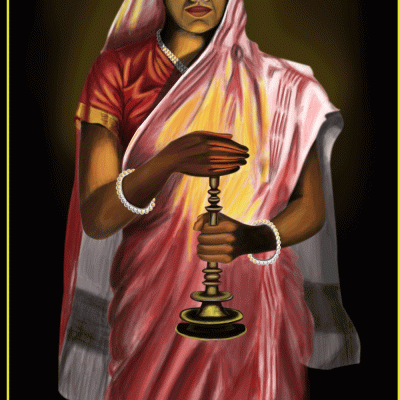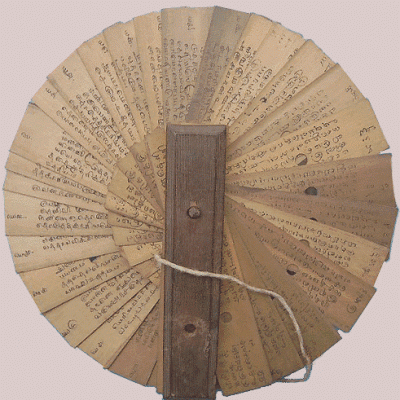“Having bowed to the deity, whose head is like an elephant; whose feet are adorned by gods; who, when called to mind, relieves his votaries from embarrassment; and bestows happiness on his worshipers; I propound this easy process of computation, delightful by its elegance, perspicuous with words concise, soft and correct, and pleasing to the learned.”
So begins Bhaskara’s Lilavati in Henry T. Colebrooke‘s classic 1817 translation. There’s an earlier Bhaskara, also famous, so Lilavati‘s Bhaskara is sometimes referred to as Bhaskara II or Bhaskaracharya. He was born in 1114 A.D. in Vijayapura (modern day Bijapur), India.
It was a quiet time. The quiet, that is, of a hurricane’s eye. In 1114 A.D., Angkor Wat was still an idea searching for its stone, but its future builder, King Suryavarman II, was already an year old. Genghis Khan was just fifty odd years away. The West hadn’t rediscovered Euclid and Aristotle yet, but Abelard of Bath and his students were in Syria, poring over the Arabic texts that would eventually ignite the Western renaissance. The Muslims had gained a foothold in Gujarat, and in the 13th through 15th centuries, they were to reinvigorate the subcontinent. And way north of Vijayapura, about 400 miles from Delhi, the last of the magnificent Khajuraho temples were being built.
Why did Bhaskara write the Lilavati? Simple. To teach duffers. As he concludes in the Bijaganita (one of his six works):
A morsel of tuition conveys knowledge to a comprehensive mind; and having reached it, expands of its own impulse. As oil poured upon water, as a secret entrusted to the vile, as alms bestowed upon the worthy, however little, so does knowledge infused into a wise mind spread by intrinsic force….What is there unknown to the intelligent? Therefore for the dull alone it is set forth.
Thanks, brah! Almost 600 years later, in his Decline and Fall, Gibbons was even more pessimistic:
“The power of instruction is seldom of much efficacy except in those happy dispositions where it is almost superfluous.”
And more recently, the late Richard Feynman— by all accounts, a great teacher— cites Gibbons with glum relish in the preface to his celebrated Lectures.
The Lilavati is a collection of worked out examples in algebra and geometry. The level of mathematics ranges between high school algebra and freshman pre-Calculus. In its time, it represented the height of 12th-century mathematics. The problems are generally addressed to one Lilavati, traditionally taken to be either his wife or his daughter. Tradition is as good a reason as any because there’s no other reason to support the claim. To modern ears, the phrasing of some of the problems is decidedly odd. Problem 2.2.16 begins with:
Beautiful and dear Lilavati, whose eyes are like a fawn’s….
Then there’s Problem 3.1.49 which begins:
Pretty girl, with tremulous eyes, if thou know the correct method of inversion…
And how can I overlook Problem 3.5.68?
The square root of half the number of a swarm of bees is gone to a shrub of jasmine; and so are eight-ninths of the whole swarm: a female is buzzing to one remaining male that is humming within a lotus in which he is confined, having allured to it by its fragrance at night. Say, lovely woman, the number of bees.
Colebrooke, thorough as always, notes that the “jasmine” referred to is the “jasminum grandiflorum.” And Ganesa Daivajna, in his Buddhivilasini< (1545 AD), supplies some context: "the lotus being open at night and closed in the day, the bee might be caught in it." Indeed. The good professor's concern is not misplaced. The hazards of being a bee are many. For poor Colebrooke, the text must have made many a warm Calcutta night even warmer.
In Bhaskara’s time, ‘shyness’– at least in Sanskrit poetics– was as much a performance, as say, cock fighting. Bees, lotuses, plantain stalks, jasmine, etc. are all conventional metaphors in Sanskrit poetry. For example, here’s one of Vittoka’s verses (verse 387 in Ingall’s transalation of Vidyakara’s treasury):
“I saw a golden staff wandering in the park
on which a wondrous lotus ever bloomed;
herein two bees; above a moon half full;
and still above, massed darkness,
which yet remained both day and night.”
The poet is talking about a young woman. The golden staff is her body, the lotus is her face, the two bees are her eyes, the “moon half full” is her fair forehead, and the massed darkness, both day and night, is her bejeweled hair. Sometimes the eyes are waterlilies, the breasts are always like golden jars, plantain stalks refer to thighs and so on and so forth. When done poorly, Sanskrit poetry is akin to cryptography, reminiscent of English metaphysical poetry.
In any event, Bhaskara’s exercises excite a real passion for mathematics. Who, but one with an adamantine heart, can resist the call of a verse such as this:
Whilst making love a necklace broke.
A row of pearls mislaid.
One third fell to the floor.
One fifth upon the bed.
The young woman saved one sixth of them.
One tenth were caught by her lover.
If six pearls remained upon the string
How many pearls were there altogether?
Note: The above is not from the Lilavati per se. It’s from the Manoranjana, a commentary written by one Ramakrishna Deva. Colebrooke spotted its connection with Bhaskara’s Problem 3.2.54 and decided to– god bless him– footnote it.
Lilavati is not exactly Aguilera-dirrty. Problems involving randy geese, bees trapped in lotuses, girls with tremulous eyes and so on are, I’m sorry to report, relatively few in number. One of the problems [3.6.75] is downright chilling:
If a female slave, sixteen years of age, bring thirty-two (nishkas), what will one aged twenty cost? If an ox which has been worked two years sell for four nishkas, what will one, which has been worked six years cost?
But most of the problems would fit in today’s calculus textbooks. They are of the ‘two doomed trains rushing towards each other with speed such-and-such…’ type. It’s the world of conical reservoirs, slipping ladders, and rectangles surmounted by semicircles. The kind of problems Frigyes Karinthy made such fun of in his delightful short story, The Refund:
If we represent the speed of light by X and the distance of the star Sirius from the Sun by Y, what is the circumference of a one-hundred-and-nine-sided regular polyhedron whose surface area coincides with that of the hip-pocket of a state railway employee, whose wife has been deceiving him for two years and eleven months with a regimental sergeant major of hussars.
If you answered “28 apricots”, you are wrong! It’s 27 apricots!
Lilavati< is now a mood, a symbol, a place and an attitude; a woman. For me, it's hard to believe it was written almost a thousand years ago. Much has changed in the world since it was written. Angkor Wat and Khajuraho are now ruin and memory. But the time-laden ponds remain. So do the lotuses and bees, forever getting entangled in eyes, thighs and mathematics.
***
Acknowledgements:
Featured Image is due to Ken Ohsawa. Check out his extraordinary captures.




casbycsi
casbycsi
i mst.AnKuR.SaBlE.I like it mathemactic are like a game
Excellent commentary.